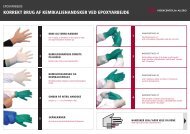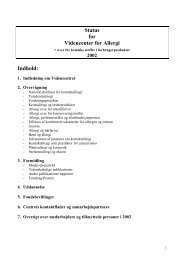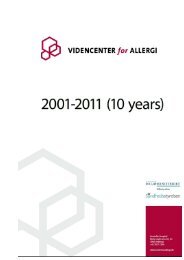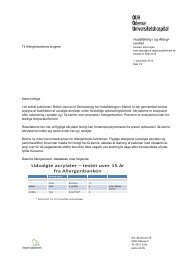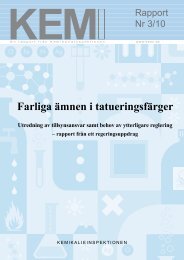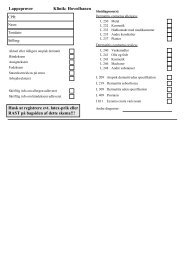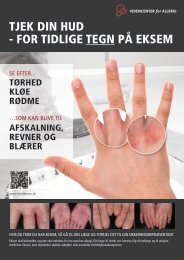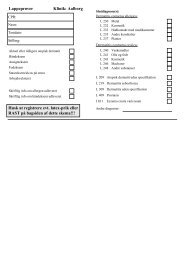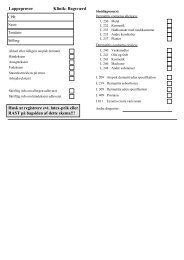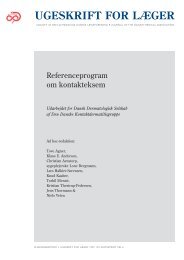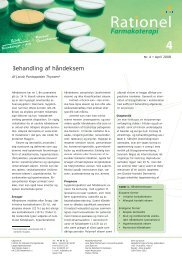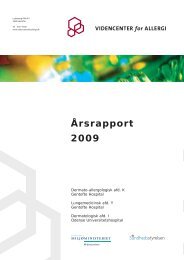Charlotte Devantier Jensen.pmd - Videncenter for Allergi
Charlotte Devantier Jensen.pmd - Videncenter for Allergi
Charlotte Devantier Jensen.pmd - Videncenter for Allergi
Create successful ePaper yourself
Turn your PDF publications into a flip-book with our unique Google optimized e-Paper software.
In recent years the cosmetic preservative methyldibromoglutaronitrile<br />
(MDBGN) has gained notice due to a significant<br />
increase in the frequency of contact allergy to the chemical in<br />
Europe. A 10-year analysis, involving 16 dermatological clinics<br />
in 11 European countries, revealed a rise in the average<br />
frequency of sensitivity to MDBGN from 0.7% in 1991 to 3.5%<br />
in 2000 in consecutive eczema patients. These observations<br />
promote MDBGN to an important contact allergen in Europe.<br />
The aim of this project was to characterize different aspects<br />
of the allergic response to MDBGN in previously sensitized<br />
individuals. During 3 clinical elicitation studies, sensitized<br />
subjects were exposed to the preservative in experimental use<br />
tests designed to resemble the actual use-situation of cosmetic<br />
products among consumers. Aspects examined were: the allergic<br />
response to MDBGN in a rinse-off product, the implication<br />
of application frequency, and the significance of previous<br />
exposure.<br />
Some types of rinse-off products, e.g. liquid soaps, are potentially<br />
used many times a day and may thus carry a similar<br />
risk of causing contact allergic contact dermatitis as leave-on<br />
products (moisturizers, lotions etc.) used only once or a few<br />
times a day. The EU Commission service has requested a revision<br />
of the use-level of MDBGN in leave-on products, while<br />
the use of MDBGN in rinse-off products is unchanged. The<br />
first experiment investigated the allergic response elicited in<br />
pre-sensitized individuals from exposure to a rinse-off product<br />
preserved with the maximum permitted level of MDBGN.<br />
19 contact-allergic individuals participated in a double-blind,<br />
randomized repeated open application test (ROAT) using two<br />
coded liquid soaps with and without MDBGN. 7/19 subjects<br />
(37%) developed allergic contact dermatitis from the MDBGNcontaining<br />
soap. The experiment showed that the exposure to<br />
a rinse-off product containing the maximum permitted level of<br />
MDBGN easily can elicit allergic contact dermatitis in presensitized<br />
individuals and indicates that the permitted level of<br />
MDBGN in rinse-off products may be too high. It is recommended<br />
that the currently allowed level of MDBGN in rinseoff<br />
products is re-evaluated.<br />
The second experiment examined whether one high-dose<br />
exposure a day of MDBGN is more or less potent than several<br />
Contact allergy to the preservative methyldibromoglutaronitrile 29<br />
SUMMARY IN ENGLISH<br />
low-dose exposures with regard to elicitation of allergic contact<br />
dermatitis in pre-sensitized individuals. This knowledge<br />
may be useful in the risk assessment and regulation of cosmetic<br />
ingredients in products potentially used several times a<br />
day. MDBGN-sensitized individuals were exposed to MDBGN<br />
in a double-blind, randomized manner both with a single highdose<br />
application a day and with 4 low-dose applications a day.<br />
The daily high-dose and multiple low-dose exposures had approximately<br />
equal capabilities of eliciting allergic contact dermatitis.<br />
According to this study, particular care must be taken<br />
in the risk assessment of products containing MDBGN that<br />
may be applied to the skin several times in one day. Examples<br />
of this could be occupationally used products, like soaps and<br />
hand-care products.<br />
The aim of the third trial was to investigate whether skin<br />
with previous dermatitis elicited by MDBGN showed an augmented<br />
response when re-exposed to the allergen. Challenge<br />
was per<strong>for</strong>med both by patch testing and in a use test with an<br />
MDBGN-containing soap. Areas of allergic contact dermatitis<br />
were elicited on the back and on the arms of 17 MDBGNsensitized<br />
individuals. After one month, the previously<br />
eczematous areas were challenged with MDBGN. On the back<br />
of the subjects, the test sites were patch tested with a serial<br />
dilution of MDBGN and a use test was per<strong>for</strong>med on the arms<br />
with an MDBGN-containing soap. A statistically significant<br />
augmented patch test response was seen on the back areas with<br />
previous dermatitis. 9 patients developed dermatitis on the arms<br />
from exposure to the MDBGN-containing soap in the use test.<br />
Of these, 8 had an augmented response on the areas with prior<br />
allergic contact dermatitis. Even though allergic contact dermatitis<br />
appears healed, an increased reactivity to exposure from<br />
the allergen that elicited the pre-existing dermatitis is present.<br />
In summary it was concluded that 1) MDBGN in rinse-off<br />
products can elicit allergic contact dermatitis in sensitized individuals,<br />
2) multiple daily exposures to MDBGN appear to<br />
accumulate, and 3) skin areas with previous allergic contact<br />
dermatitis from MDBGN are hyperreactive to re-exposure both<br />
by patch testing and in a use test even though the skin appears<br />
clinically healed.<br />
Forum <strong>for</strong> Nord Derm Ven Vol. 10, 2005 – Suppl. 8




